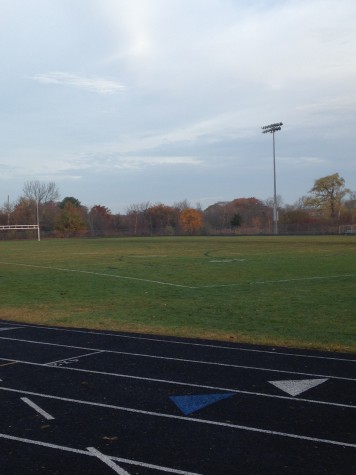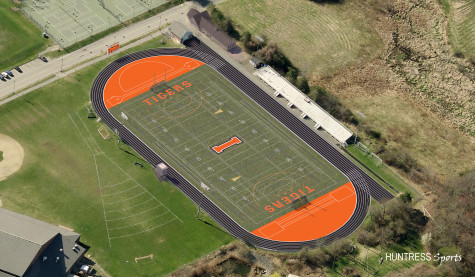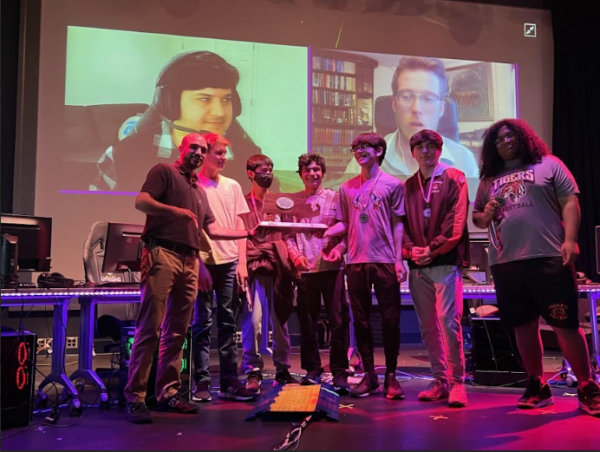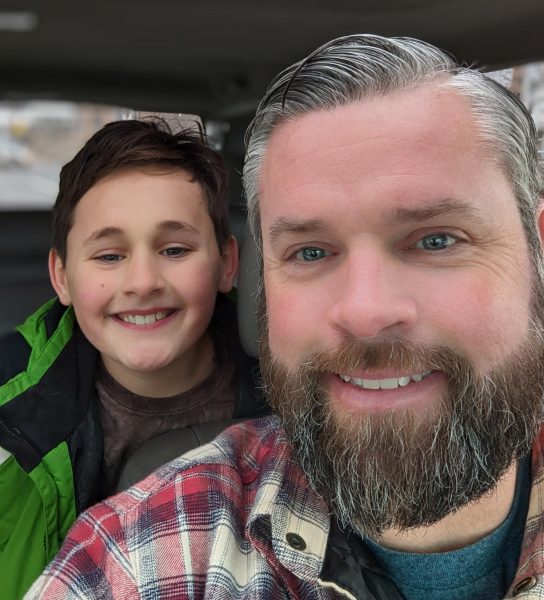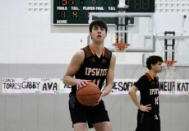Down and Dirty on Turf
November 23, 2015
Current grass field Projected design of the turf field
On the last week of October, over two hundred community conscious citizens of Ipswich, Massachusetts gathered in Ipswich High School’s Performing Arts Center to vote on various articles at the year’s Fall Town Meeting. After some heated debates on the glare and positioning of solar panels in residential yards, Article 11 was brought up to vote. Article 11 was a motion that would allow Ipswich High School to convert Jack Welsh Stadium from a grass turf field to an artificial turf field. Dr. Hugh O’Flynn spoke in favor of passing Article 11, and with many members of the community coming up to speak on behalf of the Article, the motion passed overwhelmingly. With only two concerned citizens coming out to speak against the Article, most people were blinded by the immense support for the Article to see some of the facts. This brings up the question about whether or not an artificial turf field is really the best choice for Ipswich High School.
At the town meeting, the benefits of an artificial turf field over grass turf were touted by the vast majority of those speaking. The most prominent of these benefits was a supposedly vast decrease in maintenance costs. While the initial cost of constructing an artificial turf field is very high, proponents claim that upkeep of the field is much less expensive, dropping by some estimates from an average of thirty five thousand dollars to around five thousand dollars per year. It is estimated that the artificial turf field at Ipswich High school will have a forty-five percent reduction in field maintenance cost versus the current grass field. Artificial turf also requires no watering which saves the town money and the wasting of water. On average grass turf fields waste thousands of gallons of water per week just to be maintained, and the number climbs even higher during the growing season. Not having to use so much of a vital resource will allow the town to see immediate cost savings. An artificial turf field at Ipswich is believed to produce a ninety percent savings of water versus the current grass turf. To put that into perspective, that’s over five hundred thousand gallons of water per year.
Another advantage that artificial turf offers over grass turf is that grass turf often uses harmful pesticides, chemical paints, and fertilizers. Artificial turf fields are not living, so there is no need for the use of potentially dangerous pesticides and fertilizers. Probably the most important reason that the town said the Ipswich needs a turf field was the increase playability it can offer. Artificial turf fields are much more durable than grass, offering higher playability and increased access. This means that they can be played on all the time, which also gives youth sports organizations practice space they might otherwise not have.
Weather concerns during the storms and rains in the spring and fall, which often result in the cancellation of games and practices, are no longer a problem because an artificial turf field can quite literally be played on in any weather. Just one game on a wet day can ruin a grass field for the rest of the season, but this problem is nonexistent with an artificial turf field.
It is estimated that with an artificial turf field, Jack Welsh Stadium will see a three hundred percent increase in usage, from the 76 games currently being played per year to over 300 games per year. Lastly, the durability and even playing surface of artificial turf result in fewer injuries from the field quality. Unlike grass that gets trampled and torn up by rough play, eventually turning into vast patches of slippery mud that causes twisted ankles and other injuries resulting from falling, artificial turf always remains the same high quality.
Now that the positives of artificial turf have been reviewed, it is important to get to the cons. At the town meeting, some people questioned whether artificial turf is as financially friendly as touted. Questions were raised about the need for repairs, vacuuming, and refilling, suggesting that the fields may not last as long as advertised. This then brings up the problem of going back to grass after having an artificial turf field. If say, for whatever reasons, Ipswich hates the turf field and after five years wants to go back to the original grass field, the town wouldn’t be able to do so, at least not at Jack Welch stadium. Once a community goes to an artificial turf field, it really has no choice but to install another artificial turf field once the old one needs to be replaced. Since layers of concrete and plastic covered the soil, all the nutrients and any living organisms in the subsoil are gone, making it impossible to grow grass without years of soil remediation.
Another problem that arises, especially considering that Ipswich wants to rent out the turf field over the summer, is that the heat-absorbing properties of an artificial field can make it too hot to play on in extremely warm weather. Studies show that on a 98-degree day, the temperature on the turf could rise to more than 120 degrees. A Brigham Young University study found that the surface temperature of synthetic turf at its football practice field was 37 degrees higher than the air temperature. This does raise a big concern about playing on the field in hot weather, but artificial turf proponents argue that staying hydrated and not playing during the hottest times of the day cause heat to not be an issue.
The final negative of a turf field is also likely the most concerning. Medical experts have found that staphylococci and other bacteria can survive on polyethylene plastic, the compound used to make synthetic turf blades, for more than 90 days. Blood, sweat, skin cells and other materials can remain on the synthetic turf because the fields are not washed or cleaned. Now this breeding ground of bacteria, paired with open skin lesions called turf burns put athletes at an increased risk of MRSA, a bacteria infection that has become resistant to many antibiotics used to treat it. Studies have shown that athletes who use synthetic turf are seven times more likely to receive turf burns than those who play on natural grass. These open lesions are often the source of contracting and a vehicle for the spreading of dangerous infections.
A major concern for many people regarding turf field is the use of rubber tire crumble as a filler. This crumb rubber used in turf fields has been known to contain lead, zinc, and other toxic metals such as cadmium, chromium, selenium, and arsenic. Not only do the toxins in crumb rubber affect the players on the field and the parents and friends nearby, but these chemicals can contaminate a community’s groundwater and drinking water supply through rain runoff. Luckily, Ipswich has opted for an alternative turf filler. Ipswich High School Athletic Director, Tom Gallagher, has said that the high school’s turf field will most likely use some sort of coated sand filler, which does not have any of the harmful side effects that are associated with crumb rubber.
Another point of interest at the town meeting was how exactly this new artificial turf field was going to be funded. The artificial turf field at Jack Welsh Stadium, along with the proposed bathroom, locker room, and concession facility, will cost 1.73 million dollars. It was heavily emphasized that this field will not be funded using taxpayer money and will not affect any educational programs funded by last year’s override. Instead the field will be funded with a one million dollar bond, that was passed as Article 11 at the town meeting, six hundred thousand dollars from private funding, and one hundred and thirty-two thousand from a Payne Grant.
When questioned about his opinions on the turf field, History Teacher Scott Ames said, “In general, the new artificial turf is a good idea for the town.” He cites the facts that the field is projected to save the town maintenance money and water and will hopefully also reduce field related injuries. Most importantly Mr. Ames says that the new field, “will be better for late season games” because of the increased usability of the field for all town teams. Mr. Ames does have concerns about claims that the turf field will actually generate revenue. “I just don’t see it generating new ticket sales,” exclaimed the history teacher. Another concern of his is the proposed number of games that the field is projected to be used for. “I firmly believe that the field will not be able to keep up with the number of games that will be played,” said Mr. Ames when questioned further about his concerns.
Mr. Gallagher had slightly different views on the artificial turf field, which can be expected since he is the school’s Athletic Director. Mr. Gallagher said in an interview that, “the bond [for the turf field] is going to be paid down from the school department and from the town, which has certain capital expenditures, as does the school.” What is happening is, “That funding has been prioritized towards the field. And then that money is going to be utilized to pay down the bond.” Mr. Gallagher continues stating, “The money that’s being used wouldn’t necessarily go to teachers and things like that, it would have been utilized a little bit differently.” From his understanding, the town budget that also funds the school and its programs, will fund the turf field as well, with no negative consequences for the school. When it came to talking about revenue, Mr. Gallagher was more confident than Mr. Ames was, saying the turf field should generate revenue because, “basically the field can be utilized under any weather conditions, really the only thing you have to worry about is if it’s covered in snow, or is there thunder and lightening prohibiting you from being outside.” Mr. Gallagher went on explaining that due to the more use the school can get out of an artificial turf field, the school will be able to rent on the field on weekends, holidays, and during the summertime for sports tournaments and camps. The Athletic Director is also adamant that the new turf field will be a different story than the Performing Arts Center, which was also sold to the public as a revenue producer. “It’s a little bit different with the turf field because we know that there’s a need.” explained Mr. Gallagher, “We already have people who are contacting us asking us to use the field. So in terms of it generating revenue, compared to the hope that the PAC was going to generate revenue, I believe that the field truly will, where the PAC for whatever reason fell short.”
Construction of Ipswich High School’s artificial turf field is scheduled to begin the spring of 2016, and is estimated to be completed in time for the fall sports’ seasons. The field will supposedly be able to host over three hundred games per year, hosting field hockey, lacrosse, soccer, track and field, and football teams from both the middle school and high school. Not only will the new artificial turf field be able to host all of the school’s outdoor home games, but youth sports teams will also be played on the turf, and it is believed that there will be rental opportunities throughout the year. These rental opportunities are believed to increase economic development through an increase of regional sporting organizations bringing people to town to support local retail, dining, and hospitality businesses. There are many positive aspects of Ipswich’s new turf field, and hopefully these will outweigh the purported negative aspects. Article 11 passed with overwhelming support, indicating that the town is in agreement that the turf field is Ipswich’s best option, but only time will tell if an artificial turf field is the best decision for the town.

